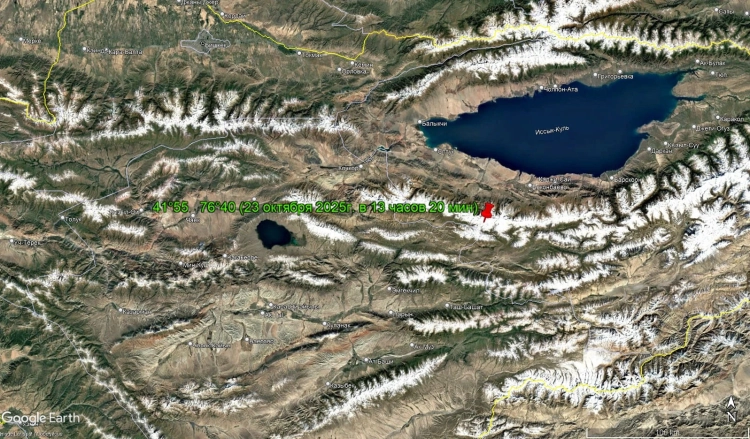
In recent years, the concept of natural heritage has increasingly entered analytical research and...

The territory of Kyrgyzstan is one of the most seismically active regions on the planet, where...

Currently, in the Chui Valley, with the formation of numerous small farms, peasant and other...

On May 13, 2014, at 07:18, an earthquake with a magnitude of 3-3.5 occurred in the Chui region....

A state insurance company is set to start operating in Kyrgyzstan on January 1, 2016. This was...

People have long been aware of the disasters caused by natural phenomena. The Kyrgyz learned about...

There are relatively few lakes in the Chui Valley and its mountainous surroundings, and all of...

Poeticization of Natural Phenomena in the Works of Democratic Akyns Toktogul and Togolok Moldo. A...

Climatic conditions, along with other factors, determine the characteristics of biological...

In certain areas of the Earth, strong underground tremors sometimes occur, a rumble is heard, and...

Peculiarities of the Psychology of the Kyrgyz People One can find the key to explaining many...

In Kyrgyzstan, the latest satellite monitoring methods have begun to be used to prevent natural...
The Ministry of Emergency Situations of Kyrgyzstan has made an official statement urging the...

Nature is the primary source of satisfying the material and spiritual needs of people. Any...

Understanding the Formation of the Universe and the Development of Living Organisms and Plants by...
In 2025, Kyrgyzstan will face a decrease in sugar production volumes due to unfavorable weather...

How long will the regression of the "pearl of Ala-Tuu" last? The famous aphorism...

Sadibakasov Ilyas (1934), Doctor of Geological and Mineralogical Sciences (1990) Kyrgyz. Born in...

According to various estimates, between 500,000 and 800,000 people have left Kyrgyzstan since...

Weather and its Predictors. Nomadic life is characterized not only by closeness to nature but also...

The Most Dangerous Roads in the World Are a Stunning Sight. Driving along the edge of a cliff...

Alongside correct, positive interpretations of natural phenomena, the Kyrgyz also held incorrect,...

The fauna of the Chui Valley is part of the Western Tienir-Tous zoogeographic region. According to...

The Chui Valley is located in the extreme southern part of the temperate zone, farthest from the...
The epicenter of the earthquake was recorded 20 km from the village of Toguz-Bulak Today, October...
Curl error: HTTP/2 stream 0 was not closed cleanly: INTERNAL_ERROR (err 2)...

Land resources refer to lands that are systematically used or suitable for use for economic...

Kyrgyzstan and Its Tourist Resources Tourism in the world is based on the targeted and reasonable...

In the Talas region of Kyrgyzstan, new methods for protecting biodiversity are being tested:...

Zhenizhok is one of the most prominent akyns of the Kyrgyz people. His real name was Ote; he lived...

Geographical Information: An astonishingly beautiful corner of nature in southern Kyrgyzstan at an...

Approximately 80 million tons of uranium waste are located in the tailings of some countries in...

How Lake Issyk-Kul Came to Be Many legends have been woven by the people about how Lake Issyk-Kul...

50% of the Flora of Kyrgyzstan Consists of the Largest Number of Useful Species Analyzing the...

Ancient Kyrgyz Ideas about the Structure of the World Human thought has never been satisfied with...

All elements and conditions, as well as phenomena and bodies of nature, can be used in public...

The Earth's Population This is the total number of people living on our planet. As of today,...

The main structures of the Chui Basin and its mountainous framing were formed by Baikal and...

Today, at 13:20, an earthquake with a magnitude of approximately 3.5 on the MSK-64 scale occurred...

The concept of folk music (traditional music, musical folklore) is relative in its genesis. It...

Pollution, in a broad sense, is understood as the introduction of new (usually non-characteristic...

Seven Phenomena of Happiness! Long ago, in a distant mountain village, there lived a sage. For his...

According to Prime Minister Temir Sariev, mandatory housing insurance for citizens will come into...

According to the Ministry of Internal Affairs of the Kyrgyz Republic, the man who spread the...

Kyrgyzstan's tourism has great potential, but the problems are even greater To improve the...
A raid was conducted in the Alamedin district, organized by inspectors from the Regional...

Rare Natural Phenomena Some natural phenomena are amazing meteorological and climatic events that...

The clearest water is found in the Sargasso Sea (Atlantic Ocean). There are over 1300 types of...